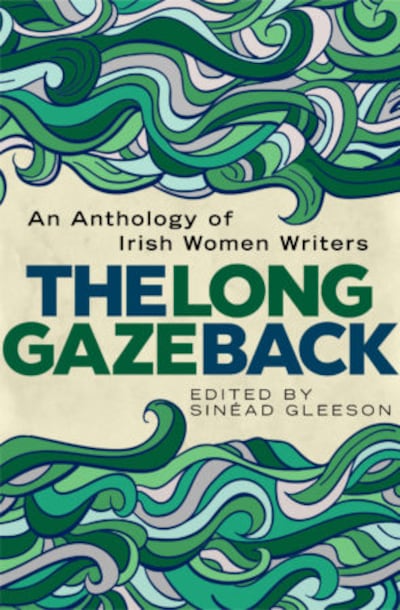
The publication of Sinéad Gleeson’s The Long Gaze Back in 2015 was an especially welcome and significant cultural moment, making readily available a compelling compendium of stories by Irish women writers from Maria Edgeworth to Eimear Ryan. Its selection now as the 2018 Dublin: One City, One Book offers an opportunity to ‘look back’ briefly on the long significance of anthologies in Irish literary history.
The term ‘anthology’ has multiple origins, including the Greek anthos meaning ‘flower’ and legein ‘to gather’. It became more current as a literary genre in the 19th century, replacing terms such as ‘cabinet’, ‘casket’ or ‘treasury’. Palgrave’s Golden Treasury of Songs and Lyrics is the most famous of poetry anthologies: first published in 1861 at a price of four shillings and sixpence, it was novel not just in content but also in its portable form, easy to carry by its increasingly mobile owners. Notably, its first editor Francis Turner Palgrave excluded works by authors then still alive, a strategy that might be envied by later anthologists faced with especially difficult and often highly contentious choices as to what living writers to include.
One of the pleasures of the anthology is that it offers us the chance to combine intensive and extensive reading, to travel easily over a diverse range of writings, some familiar and many not familiar, and to linger over favourite selections. And one of the hopes of any anthologist is that readers will be inspired to seek out more writings by the authors whom they have encountered. Here the anthology anticipates, and perhaps resolves, one of the cultural debates of our own time between proponents of ‘distant reading’ and of ‘close reading’, ie between those who argue that the much greater availability of texts in our digital age now demands a different kind of reading (both in quantity and quality) and those who stoutly defend the value of in-depth reading, albeit of a much more narrow range.
In Irish literary history, from the 19th-century Spirit of the Nation to school texts such as Soundings, anthologies have shaped generations of readers. In May 1843 publisher James Duffy published the first part of The Spirit of the Nation, drawn from works previously printed in the Nation newspaper, and sold it in a paper cover for sixpence. (At that time a farm labourer might make between eight and tenpence a day; a woman employed in spinning might earn sixpence for her day’s work, equaling the price of the anthology.) With respect to their contents, some anthologies of Irish literature have been famously controversial and divisive, prompting fierce debates concerning who’s in and who’s out. Comments by American critic Leah Price are a useful reminder of what’s at stake here: ‘anthologies’, she observes, ‘are more than a referendum. They determine not simply who gets published or what gets read, but who reads, and how.’ The last part of this statement might seem an exaggeration, before we remember how much Soundings or Lifelines or Exploring English or Poetry Now meant to their teenage readers.
Literary anthologies don’t just reflect readers’ tastes, they crucially shape and deepen them. And that is why the work of Sinéad Gleeson as editor and selector of this short story collection is so vital. Her choices from contemporary writers are sparkling. Her compelling selections from earlier generations range from better known authors (Edgeworth, Kate O’Brien) to the unjustly forgotten (Riddell, Hoult). And others of her featured authors (such as Anne Devlin or Somerville and Ross) are rescued from the ‘passing nod’ given to them within too many literary histories where a brief reference is then followed by detailed scrutiny of their male contemporaries.
We need to keep a keen eye on the fate of our contemporary women writers
Some years ago I came across the work of another anthologist who commented eloquently, as follows, on the widespread neglect of women’s writings: ‘One or two names have a high place on the roll of fame; others are rewarded with honourable if somewhat patronising mention and approval; and many whose productions are of a quality exceptionally noteworthy are totally forgotten, or – as in the case of living authors – strangely, and one is inclined to say, ungenerously neglected.’ The anthologist was Elizabeth Sharp and she wrote this comment in 1887 (yes, over 130 years ago) in her collection of poems by English, Scottish and Irish writers which she entitled Women’s Voices.
As a literary historian and feminist, I’m torn between seeing Sharp’s keen observations as deeply depressing and finding her dedicated labours inspiring. But her words do beg a central question: how do we make sure that the authors in The Long Gaze Back remain in circulation and not disappear yet again for a future anthologist to discover? The One City, One Book initiative is one exuberant answer; another is to make sure that texts by these authors enter and stay in print for future generations to encounter. The recent publication by New Island of Cocktail Bar, a collection of Norah Hoult’s short stories introduced by the indefatigable Gleeson, is hugely encouraging, as is its republication of Mary Lavin’s work; similarly, Tramp Press’s timely publication of Riddell’s Struggle for Fame and works by Dorothy Macardle, to name just some examples.
As well as welcoming and supporting such publications of writers from the past, we – whether as readers or teachers or critics or publishers or bookclub members – also need to keep a keen eye on the fate of our contemporary women writers. Let’s ensure that their works stay in print, and let’s demand that they receive more than ‘patronising mention and approval’. Then the cycle of loss, retrieval and loss can be broken – finally?
Margaret Kelleher is chair of Anglo-Irish Literature and Drama, University College Dublin












